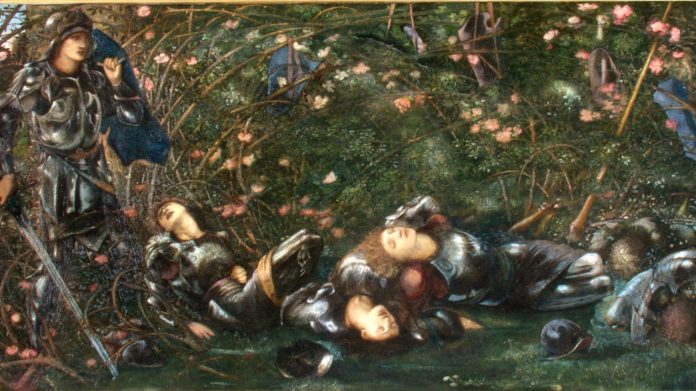Perhaps one of the lesser-known names among the Pre-Raphaelites, and yet commonly heralded as one of Britain’s greatest painters, the new Edward Burne-Jones exhibition at the Tate Modern marks the first solo showing of his work since 1933. Like the Tate Modern’s summer show-piece, Picasso: 1932, the new exhibition is rich in detail and overflows with the intensity and power of the artistry on show. Possibly one of the most profound experiences to be had in the world of art this winter, this exhibition is not one to be missed.
The exhibition begins with Burne-Jones’ early pen and ink drawings and instantly one is presented with work so thorough in detail, and so fascinating, that it’s hard not to spend hours on the first few works alone. Pieces such as Childe Roland, inspired by the Browning poem ‘Childe Roland to the Dark Tower Came’, exude intricacies, the sunflowers seeming to be tossed around by the wind, half beautiful, half monstrous – and conjure entire worlds, into which one is subsumed as if in a dream. Burne-Jones’ gothic take on the story of Noah’s ark, The Return of the Dove, with its corpses and skeletons floating in the water alongside the ark, typifies the enchanting, decadent nature of his work, which tinges, colours and permeates every piece on show. The showpiece of this first room, The Annunciation and the Adoration of the Magi uses a colour palette of golds upon rust red that paints the nativity in a new and sensual light.
The highlight of the exhibition is however its third room, which houses the best-known and most mesmerising of Burne-Jones’ works. The succession of strong-jawed women laying claim to their respective unassuming, scantily-clad men, is intoxicating as it is disturbing. Burne-Jones’ attention to detail throughout ensures the works are as striking when viewed up close as they are, arresting the gaze from afar. The exhibition also offers a glimpse into the other sides to Burne-Jones’ character, both as a man and artist; his amusing sketches paired alongside various preparatory studies and unfinished works. One such work, Souls on the Banks of the River Styx, a haunting depiction of the fate of the souls of the dead, chills as it moves, and is all the more beautiful for being left incomplete.
A series of Burne-Jones’ portraits of friends and family members explores another side to his character, whilst the exhibition is at its most immersive with its presentation of The Briar Rose series. With lines written for the piece by William Morris printed in gold along the walls, and the canvases arranged so that one’s path runs parallel with that of the prince, into the woods, the council chamber, then the court, then the bower, one seems to come upon the sleeping beauty as if a part of its dream world. The power of this series, its detail and its beauty, is wholly hypnotic. One enters the mind of the man and returns to the real world altered. Suddenly beauty lurks in the minutest of detail, and power in the simplest of gestures.
The exhibition ends with a series of tapestries, produced as a part of Burne-Jones’ long-term involvement with William Morris’ Morris & Co., which, dazzling as they are, serve to anchor one again to the material world. Thus, the experience of the exhibition itself is actualised in its construction. One is taken to new worlds, lands of fairy tale and myth, shown things beyond one’s own most-buried dreams, then these same worlds, this same beauty, is applied to material surfaces; a piano, a wall-hanging; and one leaves the exhibition with the sense that, yes, life can be that beautiful, and that decadent, and that sweetly melancholic. And thankfully there waiting for you beyond the doors of the exhibition is the gift shop, amply stocked to satisfy one’s newly replenished aesthetic needs.
An experience more than just an exhibition, this is not one to be missed; an insightful but always respectful glimpse into the mind of one of Britain’s greatest painters.
For Cherwell, maintaining editorial independence is vital. We are run entirely by and for students. To ensure independence, we receive no funding from the University and are reliant on obtaining other income, such as advertisements. Due to the current global situation, such sources are being limited significantly and we anticipate a tough time ahead – for us and fellow student journalists across the country.
So, if you can, please consider donating. We really appreciate any support you’re able to provide; it’ll all go towards helping with our running costs. Even if you can't support us monetarily, please consider sharing articles with friends, families, colleagues - it all helps!
Thank you!






